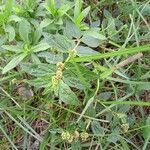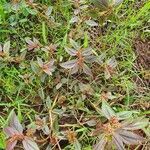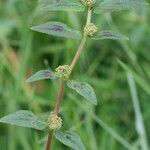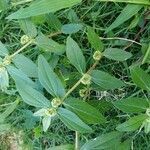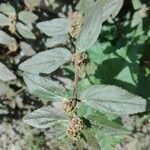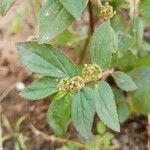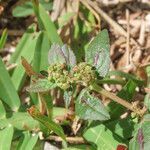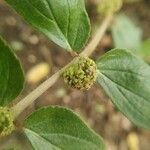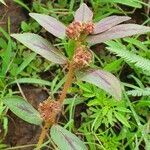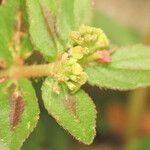Annual herb, prostrate to ascending, with branches to 50 cm. long, the whole plant pilose, including the inflorescence and capsule, with minute white adpressed hairs interspersed by yellow spreading segmented hairs ± 1.5 mm. long principally on the branches and especially on younger growth.. Leaves ovate, 1–4 × 0.5–2 cm., base very obliquely rounded, apex subacute, margin finely toothed, upper surface sometimes almost glabrous, often blotched with purple especially in the region of the midrib; petiole to 3.5 mm. long; stipules linear, rarely laciniate on lush specimens, to 2.5 mm. long.. Cyathia in dense capitate, terminal and axillary cymes to 15 mm. in diameter on peduncles to 15(–20) mm. long, occasionally subtended by 1–2 small leafy bracts ± 1 cm. long; cyathial peduncles to 1 mm. long; bracts deltoid, deeply laciniate to 1 mm. long.. Cyathia ± 0.8 × 0.8 mm. with cup-shaped involucres, usually tinged with purple; glands 4, minute, elliptical, green or purplish, with minute entire white to pink appendages; lobes triangular, fimbriate.. Male flowers: bracteoles linear, fimbriate; stamens 1 mm. long.. Female flower: ovary shortly pedicellate; styles 0.4 mm. long, spreading, bifid almost to the base, with thickened apices.. Capsule just exserted on a pedicel 1 mm. long, acutely 3-lobed, with truncate base, 1 × 1.25 mm., pilose with short yellow adpressed hairs.. Seeds oblong-conical, 0.8 × 0.4 mm., pinkish brown, with slight transverse wrinkles.
Herbs, annual, 30-60(-70) cm tall, usually few branched. Root fibrous, 3-5 mm. Stem branched from middle or above, ascending to erect, rarely prostrate, ca. 3 mm thick, with mixture of long yellow-brown multicellular hairs and much shorter white hairs. Leaves opposite; stipules membranous, triangular, 0.8-1.7 mm, caducous; petiole 1-3.5 mm; leaf blade lanceolate-oblong, long elliptic, or ovate-lanceolate, 10-50 × 3-16 mm, adaxially green to red, sometimes with purple blotch along midrib, abaxially gray-green, both surfaces pilose, denser abaxially, base slightly oblique, margin entire or few serrulate below middle, finely serrulate above middle, apex acuminate or obtuse. Cyathia in dense, often headlike, pedunculate cymes at upper nodes, peduncle to 25 mm, all parts very hairy; involucre campanulate, ca. 1 × 1 mm, pilose, marginal lobes 5, triangular-ovate; glands 4, red, rounded to transversely elliptic, center slightly sunken, appendages white to reddish, narrowly elliptic to obdeltoid, to 0.3 × 0.2 mm, margin entire to slightly undulate. Male flowers 4 or 5; anthers red. Female flower: pedicel short, exserted from involucre; ovary 3-angular, sparsely pilose; styles free; stigma slightly 2-lobed. Capsule 3-angular, 1-1.5 × 1-1.5 mm, smooth, shortly pilose; fruiting peduncle to 1.5 mm. Seeds subglobose-tetragonal, 0.7-0.9 × 0.4-0.5 mm, reddish, sides transversely furrowed; caruncle absent. Fl. and fr. Jun-Dec. 2n = 18*.
Annual, usually erect or spreading. Stems moderately to densely hairy, 10-30 cm long, branched or not from base. Lvs opposite, sparsely to moderately hairy above, usually densely hairy below, shortly petiolate, serrate, ovate to elliptic, acute, asymmetric at base, (6)-10-20-(30) mm long, often with a purple spot about midvein; stipules triangular, free, c. 1 mm long, often with long linear divisions. Cyathia in small, axillary or terminal, leafless clusters along branches. Glands ovate or orbicular, entire. Capsule smooth, grooved, sparsely to moderately clothed in appressed hairs; keels sharp. Seeds rugulose, 4-angled, reddish brown, 0.7-1 mm long.
A herb. It can grow as an annual or keep growing from year to year. It grows to 15-60 cm high and spreads to 15 cm wide. The stems lie over and are dull reddish green and hairy. The leaves occur opposite one another and are 5 cm long. The are broadly oblong and with fine teeth long the edge. The flowers are small and occur in the axils of leaves. They are separately male and female and gathered into groups. The fruit are hairy and 3-celled. They are about 1.2 mm across. They are an irregular shaped with ridges across them.
Leaves with a petiole to 3.5 mm long; stipules to 2.5 mm long, linear, rarely laciniate on lush specimens; lamina 1–4 × 0.5–2 cm, ovate, apex subacute, base very obliquely rounded, margin finely toothed, upper surface sometimes almost glabrous, often blotched with purple especially in the region of the midrib.
Decumbent to erect, to 6 dm, usually conspicuously hairy, with oblong or lance-oblong lvs 1–4 cm and the fls numerous in dense, axillary and terminal, often peduncled clusters, is widespread in trop. and warm-temp. regions, including s. U.S., but only rarely adventive and probably not persistent with us.
Annual herb, prostrate to ascending, with branches to 50 cm long; whole plant pilose, including inflorescence and capsules, with minute white appressed hairs interspersed by yellow spreading segmented hairs c. 1.5 mm long principally on the branches and especially on younger growth.
Cyathia c. 0.8 × 0.8 mm, with cup-shaped involucres, usually tinged purple; glands 4, minute, elliptical, green or purplish, with minute entire white to pink appendages; lobes triangular, fimbriate.
Cymes terminal and axillary, densely capitate to 15 mm diameter on peduncles to 15(20) mm long, occasionally subtended by 1–2 leaf-like bracts c. 1 cm long; cyathial peduncles to 1 mm long.
Capsule just exserted on a pedicel 1 mm long, 1 × 1.25 mm, acutely 3-lobed with truncate base, pilose with short yellow appressed hairs.
Female flower: ovary shortly pedicellate; styles 0.4 mm long, spreading, bifid almost to the base, with thickened apices.
Seeds 0.8 × 0.4 mm, oblong-conical with obscure transverse wrinkles, pinkish-brown.
An erect or decumbent herb, to 18 in. high, sometimes purple-tinged
Male flowers: bracteoles linear, fimbriate; stamens 1 mm long.
Bracts to 1 mm long, deltoid, deeply laciniate.
A common weed.
